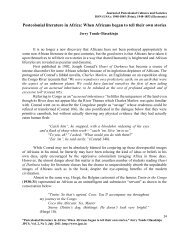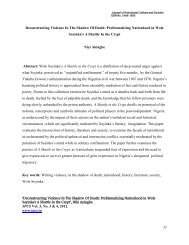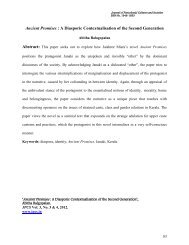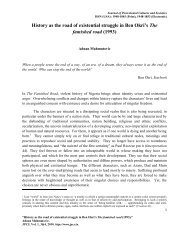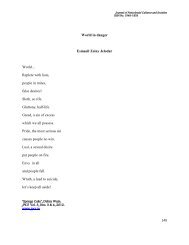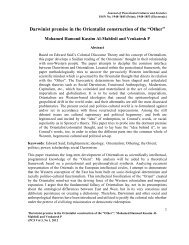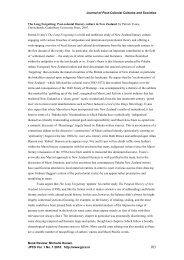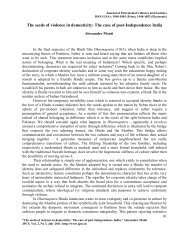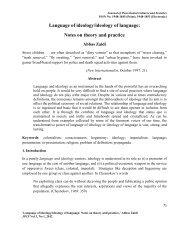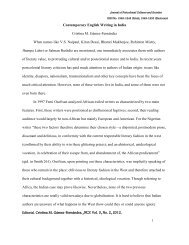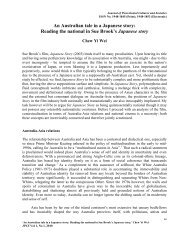'Crossing Thresholds': Radical Notes in Women's Writings ... - JPCS
'Crossing Thresholds': Radical Notes in Women's Writings ... - JPCS
'Crossing Thresholds': Radical Notes in Women's Writings ... - JPCS
You also want an ePaper? Increase the reach of your titles
YUMPU automatically turns print PDFs into web optimized ePapers that Google loves.
Journal of Postcolonial Cultures and SocietiesISSN No. 1948-1845 (Pr<strong>in</strong>t); 1948-1853 (Electronic)aga<strong>in</strong>st the entire tribal society‘(Devi 2001: xi). Thus, <strong>in</strong> her we f<strong>in</strong>d the concretealternative to resist and destroy not only the <strong>in</strong>justice of gender politics but also the<strong>in</strong>cursion upon tribal land and forests by feudalism, colonialism, and global capitalism.As a result, the subaltern figure of Mary Oraon become s a metaphor for tribals andmarg<strong>in</strong>alized people all over the globe. The story of Mary‘s resistance also po<strong>in</strong>ts to the‗profound ecological loss‘, ‗complicity of local developers with the forces of globalcapital‘ (Spivak2001:201)Secondly, Mary‘s act of kill<strong>in</strong>g her ardent suitor and sexual harasser and a wealthy loggerTehsildar S<strong>in</strong>gh from the city, is a clear statement of transcend<strong>in</strong>g and destroy<strong>in</strong>g bothpatriarchies that are totally corrupt. Moreover, by this very act, Mary challenges thedom<strong>in</strong>ant structures of middle-class, upper-caste heteronormative fem<strong>in</strong><strong>in</strong>ity andgendered subjectivity. And, f<strong>in</strong>ally, Devi merges the ritual of the tribal women's huntwith Mary's murder of her suitor, suggest<strong>in</strong>g that <strong>in</strong>digenous practices still provide afertile ground for myths that can be deployed to combat contemporary oppressions. As acreative artist, however, she would not like to allow the First World reader to understandher work as an exotic artifact of the Third.Contemporary women's writ<strong>in</strong>g <strong>in</strong> India has moved away from the conf<strong>in</strong>es ofdomesticity to engage with the historical, political and economic dimensions of the publicspace. <strong>Women's</strong> poetry <strong>in</strong> India has responded to communal violence <strong>in</strong> their own way.Writers like Saroop Dhruv ‗transcend their class-religion-region affiliations and adopt acosmopolitan liberal-humanist secular stance to document their anguish (Beniwal andMehta 2011) The creative response from women poets is not merely a gendered responseto escalat<strong>in</strong>g violence <strong>in</strong> the contemporary world and its devastat<strong>in</strong>g toll on women; but ismultifocal, complex and nuanced(ibid). Gujarati poet Saroop Dhruv based <strong>in</strong> Ahmedabadis also a playwright and cultural activist who writes modernist, fem<strong>in</strong>ist and politicallyengaged literature <strong>in</strong> her mother tongue. Her poem ( translated <strong>in</strong>to English) ‗It‘s All <strong>in</strong>My Hands‘ captures the agony of the poet at the communal frenzy and experiences the‘Cross<strong>in</strong>g thresholds: <strong>Radical</strong> notes <strong>in</strong> women’s writ<strong>in</strong>gs from contemporary South Asia,’Madhu S<strong>in</strong>gh<strong>JPCS</strong> Vol 2 No 4, December 201191



